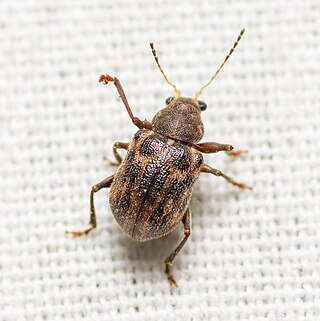
Xanthonia is a genus of leaf beetles in the subfamily Eumolpinae. It is distributed in North and Central America, and in East, Southeast and South Asia.

Colasposoma is a genus of leaf beetles in the subfamily Eumolpinae. It is known from Africa, Asia and Australia.

Platycorynus is a genus of leaf beetles in the subfamily Eumolpinae. It is distributed in Africa and Asia.

Macrocoma is a genus of leaf beetles in the subfamily Eumolpinae. It contains about 100 species, which are found in tropical Africa, around the Mediterranean, on the Canary Islands, in western and central Asia, and in India.

Afroeurydemus is a genus of leaf beetles in the subfamily Eumolpinae, found in Africa. The genus was separated from Eurydemus in 1965 by Brian J. Selman, who moved all African species of Eurydemus he had seen to this genus or related African genera and considered it likely that Eurydemus was restricted to Fiji. Many species were also originally placed in Syagrus.

Paraivongius is a genus of leaf beetles in the subfamily Eumolpinae. It is distributed in Africa.

Eumolpini is a tribe of leaf beetles in the subfamily Eumolpinae. It is the largest tribe in the subfamily, with approximately 170 genera found worldwide. Members of the tribe almost always have a longitudinal median groove on the pygidium, which possibly helps to keep the elytra locked at rest. They also generally have a subglabrous body, as well as appendiculate pretarsal claws.

Typophorini is a tribe of leaf beetles in the subfamily Eumolpinae. The tribe contains approximately 100 genera, which are found worldwide. Members of the tribe are mainly characterized by notches on the tibiae of the middle and hind legs, which are sometimes referred to as antenna cleaners. They also generally have a subglabrous body, as well as bifid pretarsal claws.
Abiromorphus is a genus of leaf beetles in the subfamily Eumolpinae, including two species found in eastern Asia. It was first described by the French entomologist Maurice Pic in 1924 for a single species from China. It is similar to Abirus, and is distinguished by simple tarsal claws and thick femurs.

Chrysochus is a genus of leaf beetles in the subfamily Eumolpinae. It is known from North America, Europe and Asia.
Chloropterus is a genus of leaf beetles in the subfamily Eumolpinae. It is distributed in Eastern Europe, West to Central Asia and North Africa.
Eryxia is a genus of leaf beetles in the subfamily Eumolpinae. It is distributed in Africa and Western Asia.
Malegia is a genus of leaf beetles in the subfamily Eumolpinae. It is known from Africa, Asia and the Caucasus.
Pagria is a genus of leaf beetles in the subfamily Eumolpinae. It is known from Africa, Asia and Australia.
Aphilenia is a genus of leaf beetles in the subfamily Eumolpinae. It is distributed in Central and East Asia as well as southern Russia. Members of the genus are adapted to dry climates, and feed on bushes of the genus Calligonum. In 2012, the genus was moved from the tribe Bromiini to the tribe Nodinini.

Trichochrysea is a genus of leaf beetles in the subfamily Eumolpinae. It is distributed in Asia.
Atomyria is a genus of leaf beetles in the subfamily Eumolpinae. It is distributed in Central Asia and Iran. In 2012, the genus was moved from the tribe Bromiini to the tribe Nodinini. In 2020, the genus was revised by A. G. Moseyko, who described a new species and transferred two species to Chloropterus, leaving only two valid species remaining within Atomyria.
Pachnephoptrus is a genus of leaf beetles in the subfamily Eumolpinae. The genus includes four species; one of them, P. weisei, is distributed from the Transcaucasus to Central Asia, while the other three are found in the Himalayas.

Bromiini is a tribe of leaf beetles in the subfamily Eumolpinae. The tribe contains approximately 120 genera, which are found worldwide. They are generally thought to be an artificial group, often with a subcylindrical prothorax without lateral ridges and covered with setae or scales.










